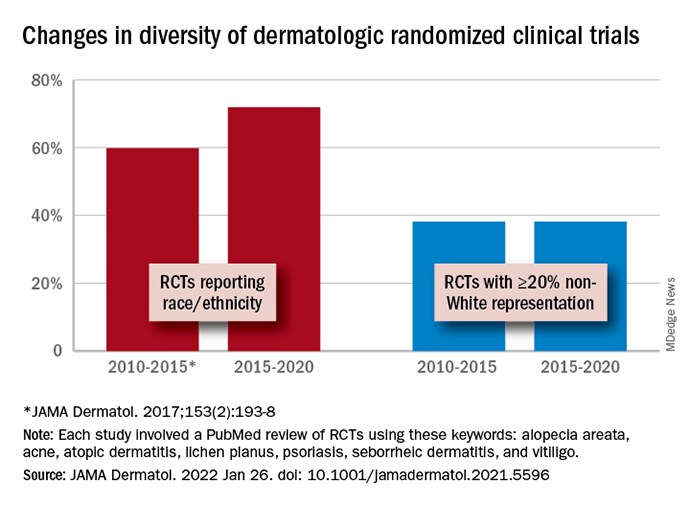Dermatology researchers have become more transparent when reporting racial and ethnicity data over the last decade, but the diversity of patients enrolled in the trials themselves has not changed significantly, according to literature reviews for 2010-2015 and 2015-2020.
Race and ethnicity were reported in 75.3% of the randomized clinical trials (RCTs) involving dermatologic diseases that were published over the 5-year period from 2015 to 2020, said Vivien Chen, BS, and associates in the department of dermatology and cutaneous surgery at the University of Miami.

In the earlier analysis, conducted by different investigators and published in 2017, race and ethnicity were reported for 59.8% of dermatology RCTs published from 2010 to 2015.
Since that initial evaluation, “there have not been significant changes in representative inclusion for racial and ethnic minority groups,” however, as both analyses produced the same result: The non-White share of the patient population was 20% or more in 38.1% of the exclusively U.S.-based RCTs included during the two time periods analyzed, Chen and associates said.
Disease type had a noticeable effect on racial/ethnic distribution representation. Among the RCTs focusing on psoriasis, which were the most numerous in 2015-2020 (268 of the total 392), only 12.1% had a 20% or greater non-White representation versus 71.1% for eczema trials (n = 64) and 53.1% for acne (n = 53). “While this finding may reflect the slight predominance of White participants reported by several epidemiologic studies on psoriasis, prevalence among other racial groups may be underestimated and should be represented in studies,” they wrote.
RCT counts were much lower for the other disease types included: vitiligo (two), alopecia areata (three), and seborrheic dermatitis (two), the investigators reported.
Patient sex also was covered in both analyses, with reporting of sex distribution increasing from 85.0% of RCTs in 2010-2015 to 91.6% in 2015-2020 but representation (≥45% women) dropping from 55.8% to 41.3%, Chen and associates said.
The effect on representation in psoriasis studies was even greater, as the proportion of studies having at least 45% women fell from 87.2% in 2010-2015 to just 29.5% in 2015-2020, although the inclusion of studies outside the United States in the 2010-2015 analysis may have been a factor, they noted. Representation for women declined from 69.4% to 59.4% for eczema RCTs but increased from 41.1% to 75.5% for acne.
Changes in the specialty may have had an effect. “The scope of our study was limited to the dermatological conditions included in the original study, to facilitate direct comparison between time periods. However,dermatologic research has expanded significantly within the last 5 years in other areas including hidradenitis suppurativa, prurigo nodularis, and frontal fibrosing alopecia,” they said.
This article originally appeared on MDedge.com, part of the Medscape Professional Network.
Source: Read Full Article
